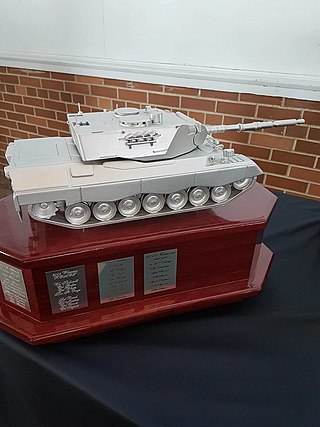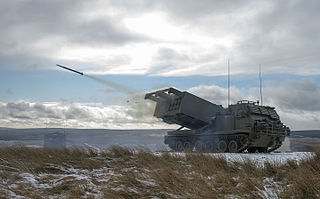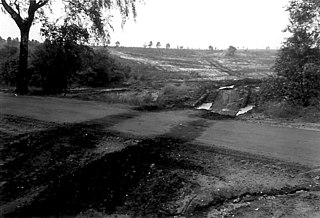
The Canadian Army is the command responsible for the operational readiness of the conventional ground forces of the Canadian Armed Forces. It maintains regular forces units at bases across Canada, and is also responsible for the Army Reserve, the largest component of the Primary Reserve. The Army is headed by the Commander of the Canadian Army and Chief of the Army Staff, who is subordinate to the Chief of the Defence Staff. The Army is also supported by 3,000 civilian employees from the public service.

The M3 Lee, officially Medium Tank, M3, was an American medium tank used during World War II. The turret was produced in two forms, one for US needs and one modified to British requirements to place the radio next to the commander. In British Commonwealth service, the tank was called by two names: tanks employing US-pattern turrets were called "Lee", named after Confederate general Robert E. Lee, while those with British-pattern turrets were known as "Grant", named after Union general Ulysses S. Grant.

The Army Air Corps (AAC) is the aviation arm of the British Army, first formed in 1942 during the Second World War by grouping the various airborne units of the British Army. Today, there are eight regiments of the AAC, as well as two independent flights and two independent squadrons deployed in support of British Army operations around the world. Regiments and flights are located in the United Kingdom, Kenya, and Canada. Some AAC squadrons provide the air assault elements of 16 Air Assault Brigade, through Joint Helicopter Command.
Canadian Forces Base Borden, formerly RCAF Station Camp Borden, is a large Canadian Forces base located in Ontario. The historic birthplace of the Royal Canadian Air Force, CFB Borden is home to the largest training wing in the Canadian Armed Forces. The base is run by Canadian Forces Support Training Group (CFSTG) and reports to the Canadian Defence Academy (CDA) in Kingston.

The 12e Régiment blindé du Canada is a Canadian Army armoured regiment based in CFB Valcartier, on the outskirts of Quebec City. The regiment has both a Regular Force and a Primary Reserve unit. The 12e Régiment blindé du Canada's abbreviation is 12e RBC.

The FV4030/4 Challenger 1 is a British main battle tank (MBT) used by the British Army from 1983 to 2001, when it was superseded by the Challenger 2. The majority of the Challenger 1 fleet was subsequently sold to Jordan where it remained in service with the Royal Jordanian Army until withdrawals were announced in 2018. Known locally as Al-Hussein, these vehicles received various Jordanian modifications before being replaced by French-made Leclerc tanks from the UAE and ex-Italian B1 Centauro 8x8 wheeled tank destroyers. The Jordanian Challenger 1 fleet had been retired by January 2023.

The Royal Canadian Armoured Corps is the armoured corps within the Canadian Army, including 3 Regular and 18 Reserve Force regiments, as well as the Royal Canadian Armoured Corps School.
5th Canadian Division Support Base Gagetown, formerly known as and commonly referred to as CFB Gagetown, is a large Canadian Forces Base covering an area over 1,100 km2 (420 sq mi), located in southwestern New Brunswick.

Canadian Forces Base Suffield is a Canadian Forces base, host to the largest army training area in Canada. It is located in southeastern Alberta, 3 nautical miles north-northwest of Suffield, 50 km (31 mi) northwest of the city of Medicine Hat and 250 km (160 mi) southeast of Calgary. It is accessible via Highway 884, a public road that bisects the main hub section of the base.

The Worthington Trophy is a Canadian military award. It was awarded annually to the best reserve armoured unit in the Canadian Land Forces. It is named after Major-General F. F. Worthington, known as Fighting Frank – "The Father of the Royal Canadian Armoured Corps".
3rd Canadian Division Support Base Detachment Wainwright, commonly referred to as Canadian Forces Base Wainwright or CFB Wainwright, is a Canadian Forces Base located in Denwood, Alberta, adjacent to the town of Wainwright.

4th Canadian Division Training Centre is a Canadian Forces training facility operated by 4th Canadian Division of the Canadian Army.
The Defence Research Establishment Suffield was the name of the military research facility located 5 km (3.1 mi) north of Suffield, Alberta, from 1967 to its renaming to DRDC Suffield in 2000.
The Crown Village of Ralston is east of Highway 884 on CFB Suffield within Cypress County in southern Alberta, Canada. It is approximately 3 km (1.9 mi) north of the Hamlet of Suffield and the Trans-Canada Highway.

A military training area, training area or training centre (Canada) is land set aside specifically to enable military forces to train and exercise for combat. Training areas are usually out of bounds to the general public, but some have limited access when not in use. As well as their military function, they often serve as important wildlife refuges. They are distinct from proving grounds which are designed for purposes such as testing weaponry or equipment.

The Trojan Armoured Engineer Vehicle (AEV) is a combat engineering vehicle of the British Army. It is used to breach minefields and for many other tasks. It is currently in use with the Royal Engineers.

Castlemartin Training Area is a British Army military training area and armoured fighting vehicle range located in the Welsh county of Pembrokeshire. It was originally established for tank training by the Royal Armoured Corps in 1938. The training area is located within the Pembrokeshire Coast National Park, on the South Pembrokeshire coast.

The Soltau-Lüneburg Training Area (SLTA) was a British and Canadian military training area in North Germany from 1963 to 1994. It was governed by the Soltau-Lüneburg Agreement between the Federal Republic of Germany, the United Kingdom and Canada. The area was located in the Lüneburg Heath in the state of Lower Saxony and was used particularly by tanks and other armoured vehicles.

The Omani-British Joint Training Area is a training area established in 2019 for joint military training between Oman and the United Kingdom. It is also used as a Land Regional Hub for expeditionary warfare by the British Army.


















